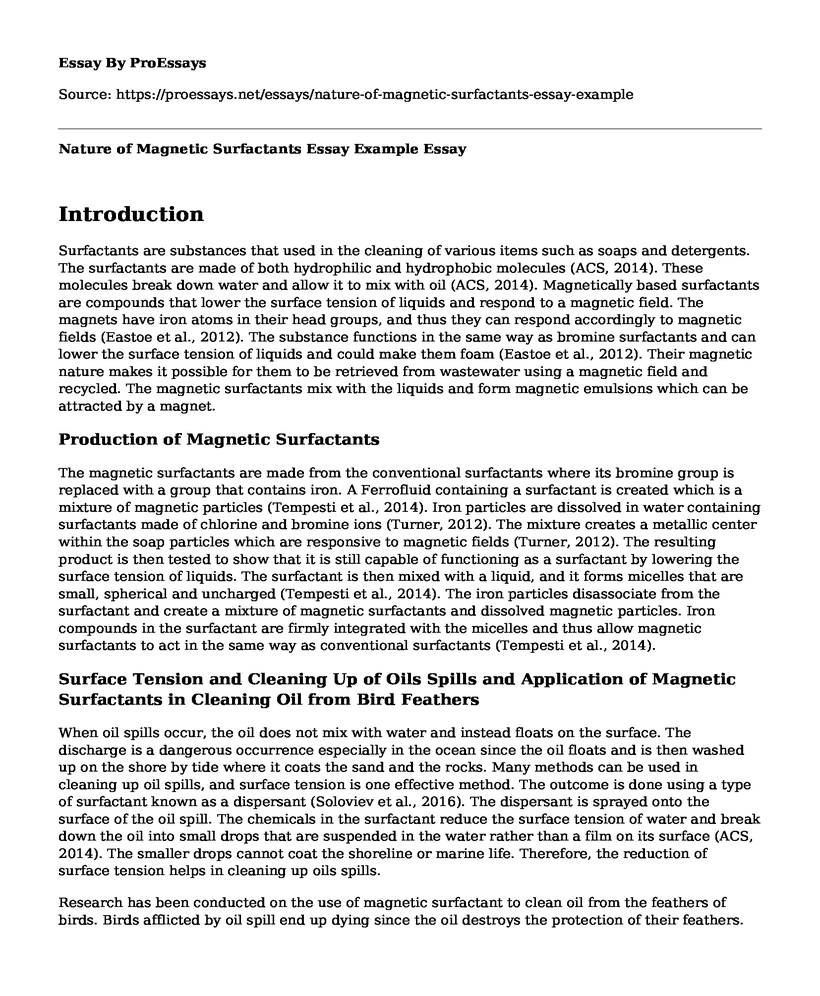Introduction
Surfactants are substances that used in the cleaning of various items such as soaps and detergents. The surfactants are made of both hydrophilic and hydrophobic molecules (ACS, 2014). These molecules break down water and allow it to mix with oil (ACS, 2014). Magnetically based surfactants are compounds that lower the surface tension of liquids and respond to a magnetic field. The magnets have iron atoms in their head groups, and thus they can respond accordingly to magnetic fields (Eastoe et al., 2012). The substance functions in the same way as bromine surfactants and can lower the surface tension of liquids and could make them foam (Eastoe et al., 2012). Their magnetic nature makes it possible for them to be retrieved from wastewater using a magnetic field and recycled. The magnetic surfactants mix with the liquids and form magnetic emulsions which can be attracted by a magnet.
Production of Magnetic Surfactants
The magnetic surfactants are made from the conventional surfactants where its bromine group is replaced with a group that contains iron. A Ferrofluid containing a surfactant is created which is a mixture of magnetic particles (Tempesti et al., 2014). Iron particles are dissolved in water containing surfactants made of chlorine and bromine ions (Turner, 2012). The mixture creates a metallic center within the soap particles which are responsive to magnetic fields (Turner, 2012). The resulting product is then tested to show that it is still capable of functioning as a surfactant by lowering the surface tension of liquids. The surfactant is then mixed with a liquid, and it forms micelles that are small, spherical and uncharged (Tempesti et al., 2014). The iron particles disassociate from the surfactant and create a mixture of magnetic surfactants and dissolved magnetic particles. Iron compounds in the surfactant are firmly integrated with the micelles and thus allow magnetic surfactants to act in the same way as conventional surfactants (Tempesti et al., 2014).
Surface Tension and Cleaning Up of Oils Spills and Application of Magnetic Surfactants in Cleaning Oil from Bird Feathers
When oil spills occur, the oil does not mix with water and instead floats on the surface. The discharge is a dangerous occurrence especially in the ocean since the oil floats and is then washed up on the shore by tide where it coats the sand and the rocks. Many methods can be used in cleaning up oil spills, and surface tension is one effective method. The outcome is done using a type of surfactant known as a dispersant (Soloviev et al., 2016). The dispersant is sprayed onto the surface of the oil spill. The chemicals in the surfactant reduce the surface tension of water and break down the oil into small drops that are suspended in the water rather than a film on its surface (ACS, 2014). The smaller drops cannot coat the shoreline or marine life. Therefore, the reduction of surface tension helps in cleaning up oils spills.
Research has been conducted on the use of magnetic surfactant to clean oil from the feathers of birds. Birds afflicted by oil spill end up dying since the oil destroys the protection of their feathers. The feathers have tiny barbs that sticks together to keep the bird dry and warm (ACS, 2014). Oil, however, makes the feathers stick together and allows water and air to get in, which makes the bird die from cold (ACS, 2014). The conventional methods applied to remove the oil from the birds also leads to the removal of protective oils that make the feathers of the water repellent. The magnetic surfactants can be used as a gentle way of cleaning the birds (Turner, 2012). Various experiments have been conducted on iron powder, and show that the magnetic surfactants are as efficient as the non-magnetic (Eastoe et al., 2012). Lab tests show that the surfactants remove oil and soil effectively on any surface.
References
ACS. (2014). Celebrating chemistry. American chemical society. Retrieve from: https://www.acs.org/content/dam/acsorg/education/outreach/cced/CCED-2014-Celebrating-Chemistry-English.pdf
Eastoe, J. G., Brown, P., Grillo, I., & Harrison, T. G. (2012). Magnetic science: Developing a new surfactant. Science in School, 25, 22-27.
Soloviev, A. V., Haus, B., McGauley, M. G., Dean, C. W., OrtizSuslow, D. G., Laxague, N. J., & Ozgokmen, T. M. (2016). Surface dynamics of crude and weathered oil in the presence of dispersants: Laboratory experiment and numerical simulation. Journal of Geophysical Research: Oceans, 121(5), 3502-3516.
Tempesti, P., Bonini, M., Ridi, F., & Baglioni, P. (2014). Magnetic polystyrene nanocomposites for the separation of oil and water. Journal of Materials Chemistry A, 2(6), 1980-1984.
Turner, J. (2012). Oil Spill Response Technology: Potential of Magnetic Soap. Offshore Technology. Retrieved from: https://www.offshore-technology.com/features/featureoil-spill-response-technology-the-potential-of-magnetic-soaps/
Cite this page
Nature of Magnetic Surfactants Essay Example. (2022, Jul 20). Retrieved from https://proessays.net/essays/nature-of-magnetic-surfactants-essay-example
If you are the original author of this essay and no longer wish to have it published on the ProEssays website, please click below to request its removal:
- Banning of Toxic Chemicals in Food by FDA Essay
- Paper Example on Radioactivity
- Letter to the G'Vany Riq'Ioty about Cosmological Structural Setup
- Assignment Example on Energy Strength of the Bond
- Engineering Units at Unilever Functions and Organizational Structure Essay Example
- What Should Ray Include in His Job Description for the Director of Engineering Position? - Essay Sample
- Essay Example on Atomic Structure: Proton, Neutron, Electron







